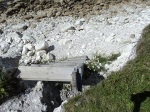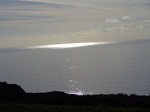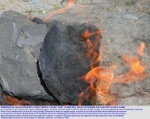The new Featured Writer is E.E Nobbs who is an amazing poet from PEI, Canada. Her idiosyncratic poems are always an enigma and a delight. It’s high time a poetry collection of hers lit the world. I don’t know if she might like the zig zag path up White Nothe on the Dorset coast, which is known to us as Smugglers’. It climbs the white cliff that looks out across Ringstead Bay towards Portland and takes you to the old Coastguard Cottages. Built in the early 1900 they must surely have rather scuppered the smugglers. The grass billows and swishes and the path itself is sheep-narrow. There are places where if you slipped or tripped you would not stop yourself slithering down a steep drop to the rocks and sea below.
On Sunday Nov 18th the sky was sparkling blue and the sun was shining on a sea so still the road of light it created twinkled only slowly. A perfect day for Smugglers’.
The last time we were here was in the summer on the first day of the Olympic Sailing and the first race started down below as we made our ascent and which we then watched from the top of the path.
We left the car in the NT car park above Ringstead and walked down to Holworth, passing the lovely little wooden church of St Catherine by the Sea, movable so that it can be dragged back from the edge as it advances. The panoramic graveyard contains the remains of many people who have lived in the immediate area. I remember the generous Fred Thorne and his wife who farmed at Holworth and I recognise the names of other people and their houses. We passed Rose Cottage, where the fisherman Harry Miller used to live.
From here the path descends the Burning Cliff – so-called because in 1826 after a landslip the shales started to burn and continued for a number of years. A rare phenomenon. Pleasure boats from Weymouth used to bring tourists to view the fire.
The beach is shingle and the sea churns and gnaws at the pebbles, its roar like an engine. On Sunday all was quiet. There are rocks with many kinds of fossil and the geology is stunningly varied: Chalk, Gault, Upper Greensand, oolitic Portland stone, Kimmeridge clay. To attempt to read the geology of the area is to encounter quite another language.
To reach the path from the beach you have to climb a sloping ladder that leans against the  bottom of the cliff. One day a landslide may destroy this and it may not be possible to get to or from the beach. (A path could be made up to the left of the ladder where we have to take our dogs anyway as they are afraid of the gaps in the rungs of the ladder. )
bottom of the cliff. One day a landslide may destroy this and it may not be possible to get to or from the beach. (A path could be made up to the left of the ladder where we have to take our dogs anyway as they are afraid of the gaps in the rungs of the ladder. )
The cliffs have crumbled over the years and the fallen, tilting rocks look like ruins. The deep undercliff is full of plants in a variety of micro climates: damp and cool thickets, grassy patches, impenetrable bramble patches, bare rock with thin soil in exposed places. I noticed dried teasels, the orange berries of stinking iris and some mullein plants with their huge rosettes of furry leaves. Deer and foxes shelter here and they have footpaths you can see running at impossible angles up the cliff faces.
After much zigging and zagging, gasping and giggling we reached the top to marvel at the sea and the sky and the white cliffs, swooping on towards Durdle Door and Lulworth. Another notch in my stick!
I keep doing this walk to to test my mettle, to check myself against my former self for I have to admit I have been walking it for nearly forty years. In my younger days I thought nothing of descending the path which would open up the yawning gap to the waves crawling below. But I think that I have lost a bit of that mettle as nowadays I only come up the path: after all, when ascending you do not need to look down except at your feet, one and then the other. I remember being that girl who used to walk it when the wind was blowing, delighting in the tremor of fear brought about by its dizzying effect and the swirling grass, the relief of reaching the beach and the pull and drag of the pebbles.







Thanks EE Nobbs and Rebecca for this. Great to see this in my inbox first thing today.
Abegail
This was fascinating. I’d love to see this place one day.